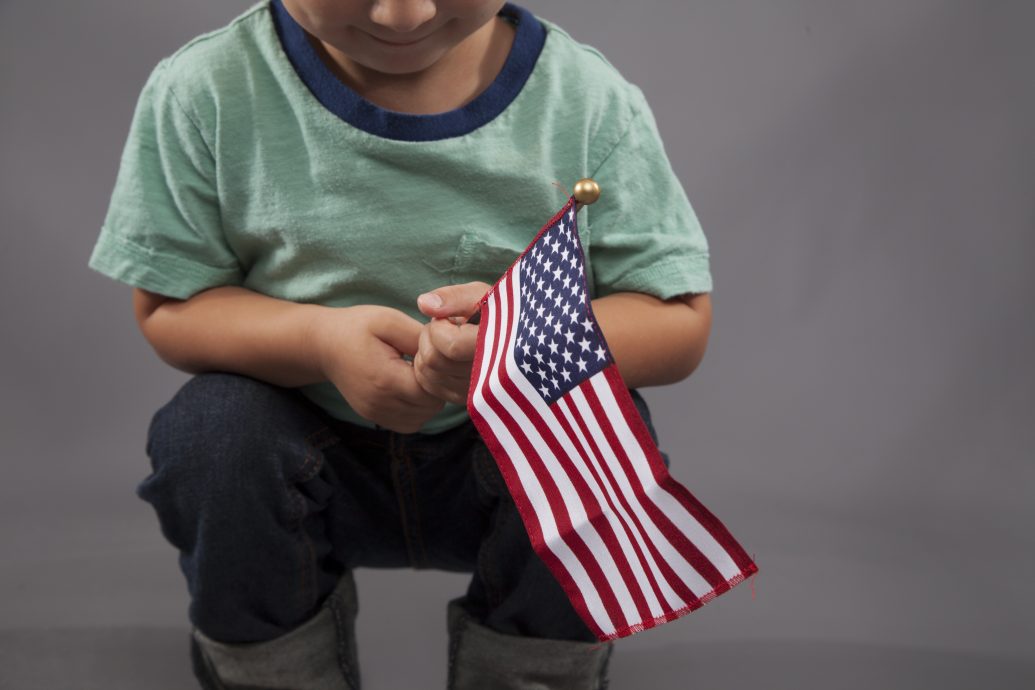Uncle Sammy Knows Best
If Lenore Skenazy’s Free-Range Kids (2009) was the book that told parents it was okay to liberate their children from the overprotective parenting expectations of their generation, Abby Schachter’s new book may be the one that tells them to liberate themselves from overprotection by government. No Child Left Alone: Getting the Government Out of Parenting will be compared to Skenazy’s book for just this reason, and not only because Skenazy wrote the foreword.
But where Skenazy’s goal was to free parents from their own counter-productive expectations, Schachter’s project is a political one. The problem for Schachter is not our view of parenting— though she is largely in agreement with Skenazy there—but the tangle of laws and regulations that have made it much more difficult for parents to raise their children as they see fit. They both say the dominant approach to parenting and the expanding role of the state in matters that used to be within the purview of parents are harming kids.
No Child Left Alone examines a number of instances where the state’s intervention has made it difficult or impossible for parents to parent they way they’d like. Each chapter tackles a different issue, ranging from breastfeeding to daycare to diet to toys, and each highlights actual parents (termed “Captain Mommies and Daddies”) who have fought various mandates or regulations to try to reclaim their rights. The book persuasively documents the range of encroachments upon parenting, and it effectively presents the arguments and data that support the author’s defense of parental authority. Schachter also lets many of the key players speak for themselves, enabling the reader to really understand the frustrations of parents. Though the book is intended for a broad audience, and not a scholarly one, Schachter did her homework as she uses interviews with, and studies by, experts on the various topics to support the activism of the parents she profiles.
The chapter on daycare, for example, focuses on the costs imposed by regulations, particularly around food and the swaddling of babies, with the latter being the issue that motivated Schachter herself to research this subject. She documents the ways in which government funding leads to government intervention—including specifying the foods to be served by daycare providers and even that brought from home. Parents who want to send food must abide by highly restrictive rules even if they have strong reason to believe, knowing their own kids better, that food from home is more likely to be eaten and is reasonably nutritious.
Rules are often incredibly detailed, such as the state of New York’s requirement about spacing coat hooks such that outer garments don’t touch each other. We read of studies demonstrating how such regulations raise costs and therefore prices that parents have to pay. We also see evidence that mandating education levels for daycare providers has no connection to good outcomes for kids. Such regulations, again, mostly just make care harder to afford for families of lower or moderate income.
A later chapter looks at the regulation of toys and playgrounds. Between our overprotectiveness of our kids, and the fear of litigation, children’s actually having fun when they play has become the exception, not the rule. The author also discusses the demise of chase games like tag at recess as schools have become increasingly unwilling to expose kids to any risks. She nicely points out that parents need to be consistent: If you want to argue that these regulations and rules are silly, you can’t change your mind and sue when it’s your kid who gets a minor injury from more risky forms of play. Much like the way in which the members of Congress are terrible except for your representative, parents are too willing to exempt themselves and their kids from their general concerns.
Schachter also makes the point that it’s a part of a child’s development to experience real risks and learn what it is like to fail or get hurt. She cites the psychologist Peter Gray’s work on the importance of unsupervised play for how kids learn negotiation, empathy, and cooperation. One of the most valuable insights in the book is one that is present in Skenazy’s book as well: There is no such thing as “perfectly safe.” All activities involve risk, and many of the childhood activities that yield large developmental benefits are risky. Even parental willingness to drive their kids everywhere carries risk—of being in a car accident, and it’s statistically much higher than the risks of most of the childhood activities that schools and governments are trying to limit or ban.
One other strength is that Schachter implicitly recognizes the need to engage in comparative analysis. It’s not enough for proponents of government intervention to point out examples where parents are imperfect. We must then ask whether government would do better. So the fact that parents don’t always make perfect decisions about their children’s nutrition or risk/reward tradeoffs does not by itself imply that government will improve upon matters. In her discussion of overly zealous child protective services agencies and obese kids, Schachter approvingly quotes Elizabeth Ralston: “Unless remaining in the home places a child in grave danger, it is unlikely that foster car is a better alternative for an obese child.” This comparative perspective and the recognition that there are no perfect solutions—longstanding approaches in political economy—are crucial to understanding the flaws of both overprotective parenting and overly intrusive government regulation.
At the end of the day, it is parents who are in the best position to ascertain what risks are worth taking for which benefits when it comes to their kids. They not only have the local and tacit knowledge to do so, they have the right incentives. Many of the parents profiled in the book make exactly this argument, and they are on solid ground in doing so. Governments by their nature are highly risk-averse as they would much rather accept the larger unseen costs of denying kids developmentally necessary forms of play or particular foods than the smaller, but very visible costs of the statistically rare injury or sickness that might result. Costs that aren’t seen won’t have political consequences the way visible ones will; thus politicians, bureaucrats, and regulators will do all they can to avoid the latter even at the large cost of the former. In this way, the incentives facing political actors are diametrically opposed to those of parents who wish to do right by their children.
This last point indicates what’s missing from Schachter’s book: answers to how and why we have ended up with Uncle Sam claiming to know best. Given her purpose and her audience, I don’t see this as a flaw in the book, but rather a set of issues that were beyond her purview. That said, I think it’s helpful to consider them in a quick historical overview that can help us understand how we’ve ended up with “no child left alone.”
At the core of what Schachter has described (and Skenazy before her) is the culmination of the modern sentimentalizing of childhood. For much of human history, childhood as we moderns understand it was largely absent. Families were units of economic production and children were expected to contribute to that effort from an early age. They were also expected, especially boys, to go out into the world and earn their own living, in some cases at 10 or 11 years of age. The idea that children should be sheltered from the outside world until having reached 18 or 22 was virtually non-existent, as few families in a world of poverty could afford to support kids that long without their making any economic contribution to the household.
With the wealth created by capitalism over the last two centuries or so, this has changed. Adult wages are high enough that families can afford to have fewer kids (whose production is no longer needed) and invest more in the ones they do have. The result has been an extension of childhood through the teenage years, and, in recent decades, an extension of adolescence into the 20s.
These same processes, along with medical advances that have reduced infant and child mortality, have brought the sentimentalization of childhood. Parents have always loved their kids, but it was difficult to express that love when resources were scarce and half of children died before age 18. To have a deep emotional investment in your kids was to open yourself to an awful lot of pain. In our own time, in which resources are greater and child mortality much lower, and in which childhood is this sheltered period of innocence, we can afford much more sentimentality about kids.
The consequence is a parental reluctance to take any sort of risk, which in turn has fed the expansion of government. No one is willing to risk harm to a child. The story that Schachter tells is the endpoint of this process. Combine this with broader political changes—especially the reduced constitutional burden of proof on the state to demonstrate the necessity of intervention that overrides individual rights, including long-established parental rights—and you end up with Uncle Sam being the biggest helicopter parent of them all.
As Schachter notes, the Supreme Court has recognized the rights of parents to raise their children “according to the dictates of [their] conscience” since Meyer v. Nebraska in 1923. The Court has also referred to children as not “mere creatures of the State” in Oregon v. Society of Sisters (1925) two years later. Those two cases remain largely good law, and have also served as the basis for other so-called “substantive due process” decisions defending individual liberties, including in Obergefell v. Hodges, which overturned bans on same-sex marriages in 2015. However, there has not been a case where parents have decided to push back against the more recent government intervention Schachter documents, perhaps because subsequent parental rights cases have placed more weight on “the best interest of the child” in limiting the scope of parental rights.
As the kind of nanny state-ism on display in No Child Left Alone continues to grow, perhaps one of Schachter’s “Captain Mommies or Daddies” will take up the fight and challenge some of this unnecessary regulation in court. It would be very interesting to see what the current Supreme Court, with its skepticism about unenumerated rights (except in cases of sexual liberty), would do with assertions of unenumerated rights of parents that it has long recognized. Schachter has done a great service by collecting so many examples of government interference with parenting. One can only hope that there is enough fight in some of the victimized parents, and enough wisdom left in the Court, to reassert the longstanding rights of parents to raise their children as they see fit, free from Uncle Sam’s grasping and incompetent hands.


